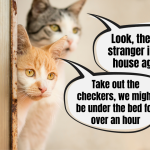Hide-and-seek is one of those competitions in which cats are unbeatable. These furry creatures can easily vanish into the least obvious places in the house when they feel like taking a nap or resting away from the company of household members. And which hiding spots do they most often utilize? Here, feline imagination certainly showcases itself, as alongside classic cardboard boxes and paper bags, there are also more imaginative hiding places, such as the bathroom sink or a drawer filled with socks.
Stay with us until the end, fabCats – today we explore why cats truly adore playing hide-and-seek, where they prefer to hide the most, and how we, as humans, can help satisfy this incredibly important need for our furry companions.
Why do cats like to hide?
Would you be surprised to hear that it’s all thanks to their wild feline ancestors? Who else could it be! As we know very well, every kitty displays plenty of instincts inherited from their furry predecessors, and the need for a solid hiding place is just one example of it. Cats in their natural environment are both predators and potential prey for larger predators. Consequently, they had to develop a solid survival strategy to maintain invisibility in their surroundings while also hunting when the opportunity arose. Hiding spots – both ground-level and elevated – work flawlessly in this regard.
A good hiding place is a location from which a cat can have a constant view of their surroundings without being seen themself. Although our domestic felines don’t have to fear being captured, the ability to hide is exceptionally useful during hunting for their favorite toy or when a kitty simply wants to take a break from the hustle and bustle of home life. Hiding spots also offer an excellent way to ensure a moment of peace and privacy, which cats, like humans, occasionally need.
The key roles of cat hideaways:
Does your cat love hiding spots? It’s no wonder! They are used by both shy and bold cats, young and old, domesticated and wild. A good hiding spot serves several crucial functions in a cat’s life:
- It provides a safe place from which to observe the surroundings.
- It helps reduce stress and allows for relaxation in seclusion.
- It provides a sense of security and the opportunity to avoid conflict.
- It can serve as a place for play, like a base from which to pounce on a “foe” in the form of a toy.
Favorite hiding spots for cats:
A fresh delivery box? A kitty inspection is mandatory! Paper bags? They don’t have the right to exist without a cat inside. But among the popular and beloved hiding places, we have a whole arsenal of spots that fulfill a crucial role: providing joy to the cat and, to some extent, a sense of security. Which of these do cats love the most?
Cardboard boxes. It doesn’t matter if they’re large or small, open or closed, came with your clothes order or a scratcher, or were built to be a cat hideaway (like the beloved MIA cat house favored by your furry companions). Their great advantage lies in their construction – with one or at most two entrances, a cat can comfortably hide inside and observe the surroundings without worrying that someone will surprise them from the other side. Cardboard retains warmth wonderfully (and we know cats appreciate that), limits light flow (favoring good naps), and, let’s face it, it’s always within paw’s reach!
Elevated hideaways. These can be both cubbies and nests at the top of vertical scratching posts, as well as shelves where a cat can rest comfortably without the risk of being bothered. Not all of them provide complete invisibility to the cat, but the advantage of height and the possibility of observing the world from above are reasons enough for a cat to feel completely secure in them. The same role can be fulfilled by the top of a wardrobe, fridge, or kitchen cabinets.
Hideaways for ground-dwelling cats. Not all cats like to climb, but all of them know that a good hiding spot is a must. Felines that spend more time on the floor can effectively hide under a blanket or duvet, under the bed, behind the couch, in cocoon-style beds, as well as in drawers and cabinets filled with our clothes. It’s warm, dark, and cozy in there – what more could you want?
Get to know the MIA house better – the purrfect hideaway for your cat designed by myKotty: https://blog.mykotty.pl/en/2022/07/18/mia-cat-house-your-cats-private-studio-apartment/
Your cats’ favorite hiding spots
Every theory needs practical confirmation, so we turned straight to you, fabCats, for the list of the best cat hideaways! On Facebook, we asked you some time ago where your furry friends most often hide. Among the answers were:
- The closet – both for clothes and shoes, in the hallway and bedroom. Of course, you can hide inside, but real hiding masters choose the top. It’s quite the feat to find them!
- The kitchen – here, the refrigerator, or rather the space on top of the refrigerator, is beloved by cats. It’s warm, and they can see the humans cooking – what more could they want?
- Cardboard – we expected such answers, but your cats still managed to surprise us. Among the hiding spots you mentioned were cardboard tissue boxes, as well as those left behind from mops, clothing purchases, and even from a board game 🙂
- Paper bag/purse – no explanation needed, cats simply love them.
- Blankets and throws – warm and cozy, and at the same time, you can burrow under them and play tricks on humans when they want to sit on the bed. Purrfect! Just be careful, cats, not to end up as pancakes 😬
- Suitcase – perhaps cats aren’t fond of traveling, but they enjoy hiding in a suitcase. Always double-check when packing, whether a purring lodger hasn’t buried itself inside.
- Bathroom – your cats hide here under towels, in the bathtub, under the shower, in the washing machine, or the laundry basket. Their creativity knows no bounds. Just to be on the safe side, we check every bathroom twice before closing the door.
The last category of hideaways we’ll simply call the unconventional ones. Because a true camouflage master doesn’t need fancy hiding spots to hide from the world. And your cats know it perfectly well! Some of them decided to hide: behind a sheer curtain, behind a stair gate, behind the television, or simply blend in with the color of the armchair they were lounging on. Were they visible? Perhaps. But when a kitty feels hidden, you should treat it as if it were invisible 🙂
When a cat hides – should we allow it?
As we know by now, hiding is entirely natural for cats. It’s an instinct passed down from our domestic felines’ wild ancestors but also a classic feline way to find a moment of peace and privacy on their own terms. So let’s allow them to do what they love so much. FabCats: leave the cardboard from the scratcher available. Set up the MIA house for the cat. Don’t hide the carrier – let it become a true sanctuary for the cat. This way, you give the cat their own M1 within your home, and at the same time, you have control over where they could potentially hide. In situations of danger, when it’s necessary to quickly catch the cat, known and easily accessible hiding spots are a true gem.
Finally, we have a brief reminder that is important in the context of the cat’s need to hide. Any deviation from the norm in cat behavior should be carefully observed and responded to accordingly. Cats that feel unwell or feel like something is wrong often use hiding spots to mask their vulnerability from others. So if your usually social cat suddenly spends most of the day hiding, it’s worth checking with a veterinarian, and after ruling out health problems, with a behaviorist. While playing hide-and-seek is a fantastic activity for cats, in some cases, it can also be a warning sign.
So, where do your cats rank on the scale from occasional hiders to hide-and-seek champions, fabCats? If you haven’t had the chance to share your furry friends’ favorite hiding spots yet, we invite you to today’s post on our Facebook page: https://www.facebook.com/myKottypl/




